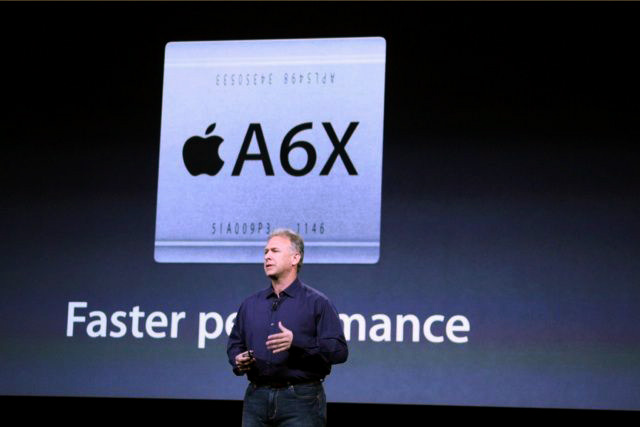
As usual, Apple didn't share many specifics about its new A6 "Extreme" (A6X) processor, which powers the fourth-generation iPad. However, by looking at Apple's claims that it's "twice as fast" as the A5X-powered third-gen iPad, it may be possible to deduce what's inside.
According to Apple, the A6X processor "delivers up to twice the CPU and graphics performance of the A5X chip." In other words, the dual-core CPU can process data twice as fast as the dual-core 1GHz, Cortex A9-based A5X. It can also churn through OpenGL triangles and textures at twice the rate of the PowerVR SGX543MP4 in the A5X. So how did Apple do that?
Looking at CPU power for the moment, we already know that Apple designed a custom ARM-based core for the A6. Running at 1.2GHz in the iPhone 5, two A6 cores run twice as fast as two 800MHz A5 cores in an iPhone 4S.
However, the A5X in the third-gen iPad was clocked at 1GHz. That means Apple is clocking the A6X higher yet. Given that architectural improvements account for some of the speed increase, Apple only had to clock the iPhone 5 at 150 percent to achieve double the compute performance of the iPhone 4S. With this in mind, we believe Apple is clocking the A6X's CPU cores at 1.5GHz.
Examining the GPU is slightly different. Apple already jammed four SGX543 GPU cores into the A5X in order to achieve performance parity with the two SGX543 GPU cores in the A5 chip that powers the iPad 2. The extra GPUs were needed just to keep up with the 2048×1532 pixel Retina display, so these did not offer any graphics performance improvement. However, Apple says that the A6X pumps pixels twice as fast.
Apple could be using a newer-generation PowerVR core, but that appears to be very unlikely. Only one announced processor is known to use a PowerVR Series6 design, and it won't even begin sampling until 2013. Given that Apple just released the A6 a month ago, we're confident Apple is still using the same SGX543 core.
Here's what we know about the PowerVR SGX543 core's performance: it scales almost linearly with the number of cores and clock speed. So to double the performance, Apple would either have to double the number of cores to eight or double the clock speed of each of the four cores. Apple says that the A6X has "quad-core graphics"—the same as the A5X—so Apple clearly boosted the clock speed. Since the GPUs in the A5X were clocked at 250MHz, we believe that Apple has clocked the SGX543 cores at 500MHz.
Given the significant boosts in clock frequency—150 percent for the CPU cores, and 200 percent for the GPU cores—you may be wondering how Apple can still promise a 10-hour battery life. After all, the iPad still has the exact same 42.5Whr battery, but the processor is twice as powerful. The power savings come from the same place as we saw in the iPhone—Apple moved from a 45nm process to a more power-efficient 32nm process. Instead of keeping performance the same and decreasing the iPad's thickness and weight, Apple instead chose to double its performance without sacrificing all-day battery life.
Of course, we won't know how accurate our educated guesses are until one of the new iPads can be thoroughly benched, and the A6X's architecture is analyzed by the likes of Chipworks. However, we feel confident suggesting Apple has mated two A6 ARM cores running at 1.5GHz with four PowerVR SGX543 cores running at 500MHz. Given the performance results we saw with the iPhone 5, we expect the updated iPad will remain at the top of the tablet performance heap for some time.
'관심사' 카테고리의 다른 글
| ipad mini review (0) | 2012.10.31 |
|---|---|
| 미IBM, 카본나노튜브 1만개를 이용한 칩 제조에 성공 (0) | 2012.10.29 |
| 아이패드 4세대 hands on (아이북스 3.0 및 게임, 카메라 구동) (0) | 2012.10.28 |
| 애플의 보이지 않는 미학, 조나단 아이브 (0) | 2012.10.26 |
| Apple, 2012년 4/4분기 실적 결과 발표 (0) | 2012.10.26 |
